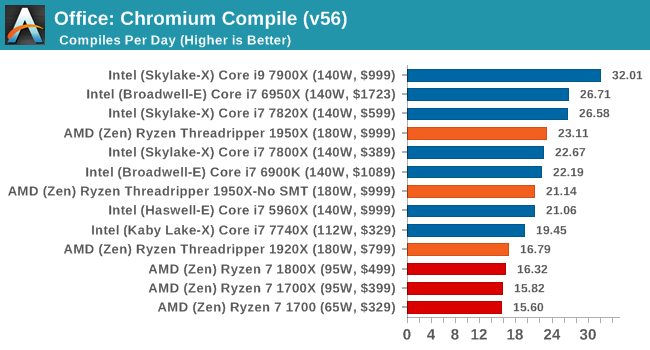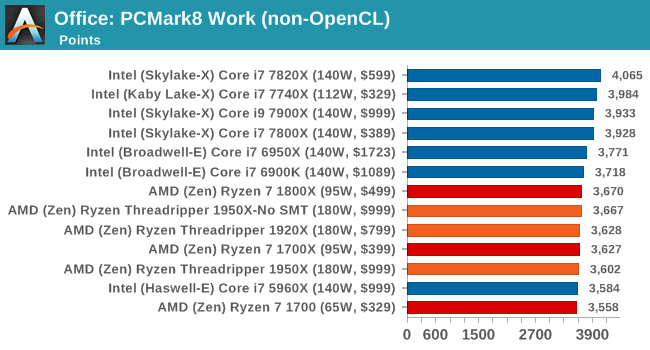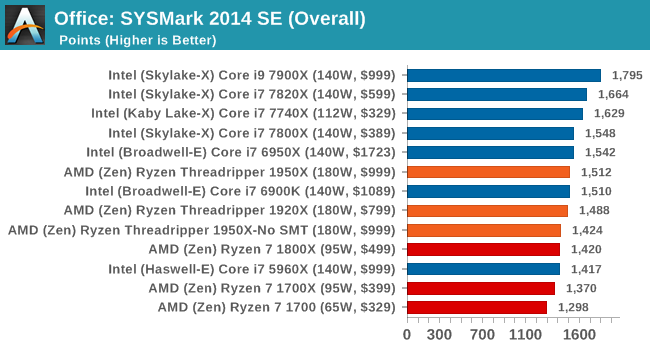The AMD Ryzen Threadripper 1950X and 1920X Review: CPUs on Steroids
by Ian Cutress on August 10, 2017 9:00 AM ESTCPU Office Tests
The office programs we use for benchmarking aren't specific programs per-se, but industry standard tests that hold weight with professionals. The goal of these tests is to use an array of software and techniques that a typical office user might encounter, such as video conferencing, document editing, architectural modeling, and so on and so forth.
All of our benchmark results can also be found in our benchmark engine, Bench.
Chromium Compile (v56)
Our new compilation test uses Windows 10 Pro, VS Community 2015.3 with the Win10 SDK to compile a nightly build of Chromium. We've fixed the test for a build in late March 2017, and we run a fresh full compile in our test. Compilation is the typical example given of a variable threaded workload - some of the compile and linking is linear, whereas other parts are multithreaded.

One of the interesting data points in our test is the Compile, and it is surprising to see the 1920X only just beat the Ryzen 7 chips. Because this test requires a lot of cross-core communication, the fewer cores per CCX there are, the worse the result. This is why the 1950X in SMT-off mode beats the 3 cores-per-CCX 1920X, along with lower latency memory support. We know that this test is not too keen on victim caches either, but it does seem that the 2MB per core ratio does well for the 1950X, and could explain the performance difference moving from 8 to 12 to 16 cores under the Zen microarchitecture.
PCMark8: link
Despite originally coming out in 2008/2009, Futuremark has maintained PCMark8 to remain relevant in 2017. On the scale of complicated tasks, PCMark focuses more on the low-to-mid range of professional workloads, making it a good indicator for what people consider 'office' work. We run the benchmark from the commandline in 'conventional' mode, meaning C++ over OpenCL, to remove the graphics card from the equation and focus purely on the CPU. PCMark8 offers Home, Work and Creative workloads, with some software tests shared and others unique to each benchmark set.


Strangely, PCMark 8's Creative test seems to be failing across the board. We're trying to narrow down the issue.
SYSmark 2014 SE: link
SYSmark is developed by Bapco, a consortium of industry CPU companies. The goal of SYSmark is to take stripped down versions of popular software, such as Photoshop and Onenote, and measure how long it takes to process certain tasks within that software. The end result is a score for each of the three segments (Office, Media, Data) as well as an overall score. Here a reference system (Core i3-6100, 4GB DDR3, 256GB SSD, Integrated HD 530 graphics) is used to provide a baseline score of 1000 in each test.
A note on context for these numbers. AMD left Bapco in the last two years, due to differences of opinion on how the benchmarking suites were chosen and AMD believed the tests are angled towards Intel processors and had optimizations to show bigger differences than what AMD felt was present. The following benchmarks are provided as data, but the conflict of opinion between the two companies on the validity of the benchmark is provided as context for the following numbers.











347 Comments
View All Comments
mapesdhs - Friday, August 11, 2017 - link
I haven't checked, is the TDP of a 32c EPYC a lot higher, with consequently higher clocks?JedTheKrampus - Thursday, August 10, 2017 - link
Here are a few potential benchmark ideas that I'd like to see.- Zbrush. (High resolution dynamesh/projection, Zremesher, or Decimation Master.)
- Unreal Engine 4. (Lightmap baking on a sample map, perhaps one from Unreal Tournament 4. Perhaps compilation of the engine itself.)
- XNormal. (Ambient occlusion texture baking.)
- Some sort of database benchmark for the poor sods who are doing web development.
- Some sort of video editor benchmark.
T1beriu - Thursday, August 10, 2017 - link
Luxmark OpenCL: "Though it's interesting just how cost the 10-thread Core i9-7900X gets here, likely due to a combination of higher IPC and clockspeeds."1. Typo?
2. 7900X it's not in the chart.
Ian Cutress - Thursday, August 10, 2017 - link
When we initially ran the 7900X and other CPUs, Luxmark was failing for no obvious reason. We narrowed down the reason a few weeks ago - it doesn't like running when a GTX 950 is installed for detection reasons. We have since moved to RX 460s being used during our CPU benchmark runs.gzunk - Thursday, August 10, 2017 - link
The only thing I might take exception at is the notion that prosumers have never seen NUMA before, since both the Z9-PE and Z10-PE offer it. I myself had the Z9-PE with a pair of Sandy Bridge Xeons.mapesdhs - Thursday, August 10, 2017 - link
I've lost count of how often I've read the specs pages for those mbds, etc. Talked to so many prosumers who ideally would buy one of those boards, but the XEON costs were prohibitive.SpartanJet - Thursday, August 10, 2017 - link
Well that was disappointing. Guess I'm waiting for Coffee Lake for my new gaming rig.Total Meltdowner - Thursday, August 10, 2017 - link
Yea, I'm not regretting my 1800x right now. Too bad. I had high hopes for threadripper.Let's see how drivers and BIOS updates help it, assuming they will.
Johan Steyn - Thursday, August 10, 2017 - link
Yes, you are right, TR is not the best gaming rig. Maybe this article misses again to even try to compare TR as a gaming machine. It is good to point out that Intel will be better, even though not compared to price. But this article made me think TR is made to be a gaming CPU. Ryzen is meant for that. When games support 32 threads, that will change, but not soon. This is a workstation class machine. It is almost like buying a Xeon to run games with.PS, I would not buy CL though.
mapesdhs - Thursday, August 10, 2017 - link
I hope AMD tailors its PR to make this clear. Focusing any hype on gaming where it's obviously not warranted could miss a lot of potential very suitable buyers.What does bug me though is the absence of reviewers mentioning that while Intel's 4-core CPUs do well for gaming right now, isolated to just that task, they have nothing in reserve to handle what are rapidly growing areas such as live streaming of games. GN showed a huge difference in viewer experience for game streaming between a 1700 and a 7700K.